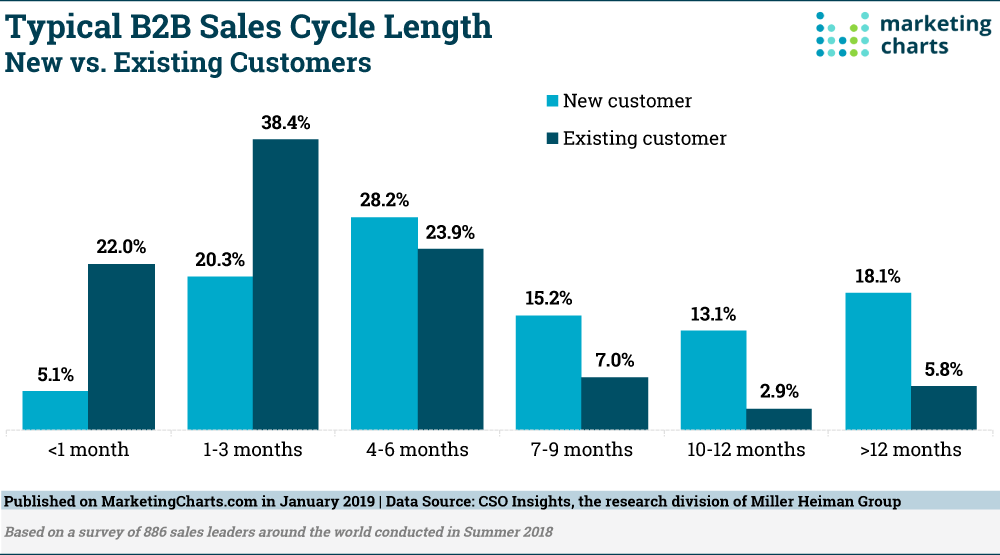How fast and efficient is your sales cycle?
Metric Stack 17: Sales Cycle Length and more
Do you know the advantages of tracking each stage of your sales cycle? B2B companies that meticulously define and follow a sales process report 18% more revenue growth when compared to companies that lack a formal sales process.
You benefit directly from tracking key sales metrics at each stage of your sales cycle. I’m Priyaanka Arora, your personal metric assistant and content researcher & writer at Klipfolio. This week on Metric Stack, let’s look at one of the most important sales metrics, Sales Cycle Length.
What is Sales Cycle Length?
Sales Cycle Length is the time it takes on average to close a deal. How you define the start and end point of closing a deal depends on your sales model. In general, the sales cycle starts with a prospect and ends with a won customer. Here’s the formula:
Sales Cycle Length = Time Taken to Close a Deal / Number of Deals
Tracking your sales cycle length can help create more accurate sales forecasts and improve the efficiency of your sales cycle. Effectively, this metric helps you measure how long, on average, you have to wait to generate revenue from potential customers.
Do keep in mind that self-serve or freemium model companies might often have a sales cycle length of one or zero. As mentioned earlier, this metric is dependent on your sales model and is mainly relevant to businesses with an active and involved sales process.
What is a good Sales Cycle Length benchmark?
The average SaaS B2B sales cycle is 83 days, with more than 50% of companies reporting an average sales cycle length of up to 6 months, according to this benchmark report:
Note how the sales cycle length is shorter for existing customers as opposed to new customers. This further highlights the importance of tracking sales cycle length: you can segment and identify customer segments with shorter payback periods and overlap this with longer LTV customers. In other words, you’re narrowing down on your best customers from both a revenue and a loyalty perspective.
Benefits of tracking sales cycle length
Ask yourself what the role of sales is in your organization. It’s likely you’d either say revenue generation or forming long-lasting customer relationships. You’d be right in assuming that, but make sure to factor in time.
Time is of the essence because it affects the present as well as the future.
As cryptic as that may sound, it simply means that you can use your current sales cycle length to build sales forecasts with accuracy, letting you budget your resources accordingly. You can then use this knowledge to formulate your business strategy.
Within your sales team, sales cycle length can be a great way to introduce transparency. You can estimate the amount of effort and time your team needs to put in to secure customers. It can also be a motivational tool as a key metric for the team to improve on.
Any disparities you detect by tracking your sales cycle length over time can indicate problems with your pricing model, lead fit issues, and sales process disparities. Sales cycle length can also vary by market size and maturity, number of stakeholders, and customer profile.
Finally, longer sales cycle lengths can be an issue of alignment between sales and marketing. The teams may have different approaches to lead qualification, and may need to align on what it means to be a well-qualified lead for your business.
Best practices to boost sales cycle efficiency
To boost sales cycle efficiency by regulating sales cycle length, make sure you adhere to the following best practices:
Increase communication between sales and marketing. Marketing pre-qualification of leads based on product usage or website engagement can save bundles of time and resources, leading to a higher probability of wins.
Set targets and time limits for each stage of the sales process from initial outreach to closed deals. This ensures that any roadblocks are brought to light quickly.
Know how to reach your target customer. Research where they “live” - online communities, review sites, and social media. Find out which channels work best to target your best-fit customer segment and focus on building authority in these channels.
Track key sales metrics to narrow down your leads and identify customer pockets that may benefit from support, attention, and offers.
Maintain a single view of all your sales data to avoid losing important insights into your sales process. A free analytics platform such as PowerMetrics can help you quickly identify areas of opportunity and improvement in sales.
Review your sales process regularly and revisit all aspects of the process based on shifts in the product or business strategy and performance. Keeping your process up-to-date with a clear understanding of the current environment will allow a sales process that is sustainable and relevant.
As Meggan King, Klipfolio's Director of Customer Success, so rightly puts it:
"It's very important to capture expectations of the process in a sales playbook that everyone works from, but also allow feedback from the sales team.”
“It's an iterative process, so we aren't afraid to make changes and try different approaches. Everyone is a stake holder in efficiency and success in the process! We are also completely transparent, so the entire company from sales to support to product to development to executive team understand the process"
Coming November 2nd: the Metric Stack Podcast
If you love the Metric Stack newsletter, you’ll love the Metric Stack podcast! Klipfolio co-founder and CEO Allan Wille and co-host Lauren Thibodeau talk to founders, leaders, marketers, and more to uncover how they succeed with data. Whether you’re struggling with data, hesitant to take the leap or you’re a seasoned expert with years of experience, you’ll hear stories from people like you who have used data to grow and scale their business. Tune in for our first episode on November 2nd on your favourite podcast app.
Stay tuned for the next edition of Metric Stack Newsletter to get the latest scoop on all things metrics! Send feedback, comments, questions here: parora@klipfolio.com



